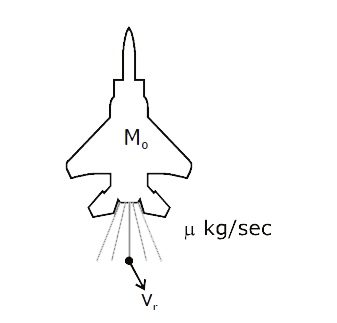A rocket ejects a steady jet whose velocity is equal to u relative to the rocket. The gas discharge rate equals μkg/s. Demonstrate that the rocket motion equation in this case takes the form
mw=F−μu,
where m is the mass of the rocket at a given moment, w is its acceleration, and F is the external force.
The correct Answer is:[F+rum]
Step by step video, text & image solution for A rocket ejects a steady jet whose velocity is equal to u relative to the rocket. The gas discharge rate equals mu kg//s. Demonstrate that the rocket motion equation in this case takes the form mw=F-muu, where m is the mass of the rocket at a given moment, w is its acceleration, and F is the external force. by Physics experts to help you in doubts & scoring excellent marks in Class 11 exams.
Updated on:21/07/2023Topper's Solved these Questions
- LINEAR MOMENTUM & ITS CONSERVATIONBOOK - PHYSICS GALAXY - ASHISH ARORACHAPTER - LINEAR MOMENTUM & ITS CONSERVATIONEXERCISE - exercise 1.3
3 Videos
- LINEAR MOMENTUM & ITS CONSERVATIONBOOK - PHYSICS GALAXY - ASHISH ARORACHAPTER - LINEAR MOMENTUM & ITS CONSERVATIONEXERCISE - Advance McQ
20 Videos
- KINEMATICSBOOK - PHYSICS GALAXY - ASHISH ARORACHAPTER - KINEMATICSEXERCISE - Unsolved Numerical Pro.
83 Videos
- NEWTONS LAWS OF MOTIONBOOK - PHYSICS GALAXY - ASHISH ARORACHAPTER - NEWTONS LAWS OF MOTIONEXERCISE - Unsolved Numerical Problem
81 Videos
Similar Questions
An isolated particle of mass m is moving in horizontal planexy along the x-axis, at a certain height above the ground. It suddenly explodes into two fragment of masses m/4 and 3m/4. An instant later, the smaller fragment is at y=+15 cm. The larger fragment at this instant is at
View SolutionIn which o the following cases the centre of mass of a rod is certainly not at its centre?
View SolutionA ball is released from rest. If it takes 1 second to cross the last 20 m before hitting the ground, find the height from which it was dropped.
View SolutionA packet of 150kg is released from an air plane travelling due east at an altitude of 7200 m with a ground speed of 100 m/s. The wind applies a constant force on the packet of 300 N directed horizontally in the opposite direction to the plane's flight path. Where and when does the packet hit the ground, (with respect to the release location and time)
View SolutionA rocket ejects a steady jet whose velocity is equal to u relative to the rocket. The gas discharge rate equals mu kg//s . Demonstrate that the rocket motion equation in this case takes the form mw=F-muu , where m is the mass of the rocket at a given moment, w is its acceleration, and F is the external force.
View SolutionA rocket moves in the absence of external forces by ejecting a steady jet with velocity u constant relative to the rocket. Find the velocity v of the rocket at the moment when its mass is equal to m, if at the initial moment it possessed the mass m_0 and its velocity was equal to zero. Make use of the formula given in the foregoing problem.
View SolutionFind the law according to which the mass of the rocket varies with time, when the rocket moves with a constant acceleration w, the external forces are absent, the gas escapes with a constant velocity u relative to the rocket, and its mass at the initial moment equals m0.
View SolutionA relativistic rocket emits a gas jet with non-relativistic velocity u constant relative to the rocket. Find how the velocity v of the rocket depends on its rest mass m if the initial rest mass of the rocket equals to m_0 .
View SolutionThe rate of mass of the gas emitted from the rear of a rocket is initially 0.1kg/s. If the speed of the gas relative to the rocket is 50m/s and the mass of the rocket is 2kg , then the acceleration of the rocket in m/s2 is
View SolutionIf rocket engine ejects fuel at the rate μ kg/s with relative velocity vr. At time t = 0, speed of rocket is u. Consider the value of acceleration due to gravity is constant and equal to g.

If rocket is in gravity free space then find velocity of rocket as function of time.
View SolutionIn a rocket, fuel burns at the rate of 2 kg/s. This fuel gets ejected from the rocket with a velocity of 80 km/s. Force exerted on the rocket is -
View SolutionDuring the rocket propulsion, gases ejecting with velocity 1 km/s relative to rocket. The rate of fuel consumption is m10 kg/s, where m is the instantaneous mass of the rocket. If air ressitance varies according to equation f=0.15 mv, then terminal velocity of the rocket is -
View SolutionIn a rocket, fuel bums at the rate of 1 kg/s. This fuel is ejected from the rocket with a velocity of 60 km/s. This exerts a force on the rocket equal to
View SolutionA rocket is ejecting a mass m of gases per unit time with velocity V relative to the rocket, the thrust on the rocket is:
View SolutionA Diwali rocket is ejecting 0.05 kg of gases per second at a velocity of 200 m//s. The accelerating force on the rocket is :
View SolutionA Diwali rocket is ejecting 0.05 kg of gases per second at a velocity of 200 m/s. The accelerating force on the rocket is :
View Solution
